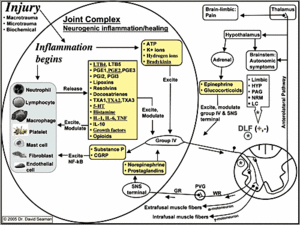For many of us, nutrition is confusing because we generally believe each condition has its own unique biochemistry, which demands a unique chemical intervention, be it drug or nutrient.
Back in 1973, Dr. Russell Ross proposed the "reaction to injury" model of atherosclerosis. It was originally thought that the some form of injurious stimulus functioned to denude the endothelium, which led to the development of atherosclerosis.1 In 1999, Ross reviewed the literature that suggests how inflammatory stimuli cause endothelium to dysfunction, which creates a local environment that promotes atherosclerosis. Robbins' Pathology, perhaps the most well-known pathology text, provides the same description.2 Various pro-inflammatory factors, such as cytokines, complement, hypoxia and advanced glycosylation end-products [from syndrome X and diabetes], lead to endothelial activation or stimulation. Activated endothelium now help to direct the atherogenic process.3
Various pro-inflammatory factors, such as cytokines, hypoxia and advanced glycosylation end-products, can lead to endothelial activation or stimulation.
In other words, due to the presence of a subclinical chronic inflammatory state, our own cells begin to alter their functional expression from one of "health and homeostasis" to "disease promotion." This allows for local tissue cells to lead the degenerative/disease process within the tissues they reside in and formerly supported and maintained; a description that echoes the autoimmune process we all have studied in the context of rheumatoid arthritis, ankylosing spondylitis, Crohn's disease and other severe inflammatory conditions. From a practical perspective, the only difference between these diseases is the location in which the chronic inflammation resides. Consider the following comments by Ross:
"The cellular interactions in atherogenesis are fundamentally no different from those in chronic inflammatory-fibroproliferative diseases such as cirrhosis, rheumatoid arthritis, glomerulosclerosis, pulmonary fibrosis, and chronic pancreatitis. The response of each particular tissue or organ depends on its characteristic cells and architecture, its blood and lymph supply, and the nature of the offending agents. Thus, the cellular responses in the arteries (atherosclerosis), liver (cirrhosis), joints (rheumatoid arthritis), kidneys (glomerulosclerosis), lungs (pulmonary fibrosis), and pancreas (pancreatitis) are similar yet are characteristic of each tissue or organ."

We now know that osteoarthritis (OA) also is driven by similar inflammatory factors; the difference being that OA is "less overtly" inflammatory compared to the diseases listed above.4 This information described thus far, would lead us to believe that resident and circulating white cells, as the local tissue cells (endothelial, fibroblasts, chondrocytes), are involved in the chronic inflammatory process. This is true. However, in the past 10-20 years, it's becoming increasingly appreciated that the nervous system plays a key role in organizing and promoting the disease process.
Neurogenic inflammation is the term given to describe the nervous system's participation in the inflammatory and disease process [see figure]. And research suggests most inflammatory diseases and pain syndromes are driven by neurogenic inflammation.4,5 More on this topic in future issues.
References
- Ross R, Glomset JA. Atherosclerosis and the arterial smooth muscle cell: proliferation of smooth muscle is a key event in the genesis of the lesions of atherosclerosis. Science 1973;180:1332-9.
- Ross R. Atherosclerosis - an inflammatory disease. New Eng J Med 1999;340:115-26.
- Kumar V, Abbas AK, Fausto N. Robbins and Cotran Pathologic Basis of Disease. 7th ed. Philadelphia: Elsevier/Saunders; 2005: p. 513-524.
- Bonnet CS, Walsh DA. Osteoarthritis, angiogenesis and inflammation. Rheumatology 2005;44:7-16.
- O'Connor TM, O'Connell J, O'Brien DI, Goode T, Bredin CP, Shanahan F. The role of substance P in inflammatory disease. J Cell Physiol 2004;201:167-80.
Click here for more information about David Seaman, DC, MS, DABCN.





